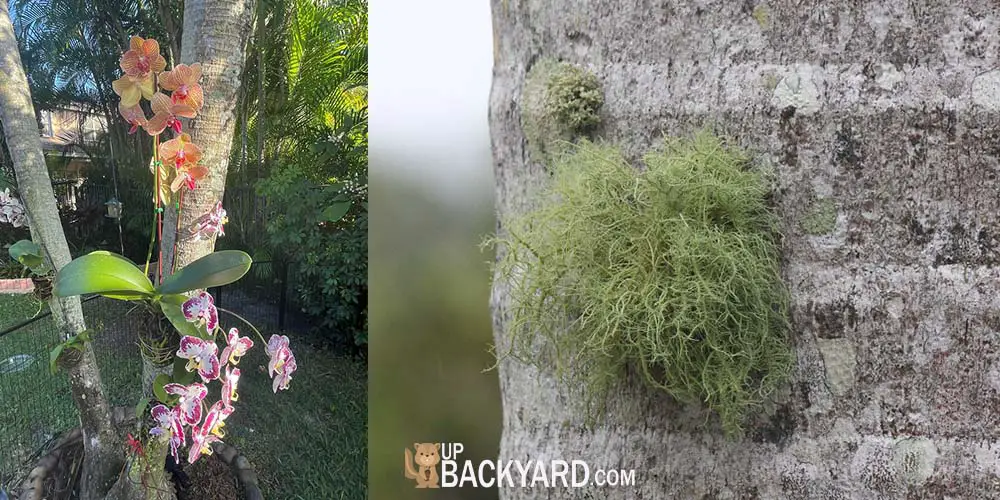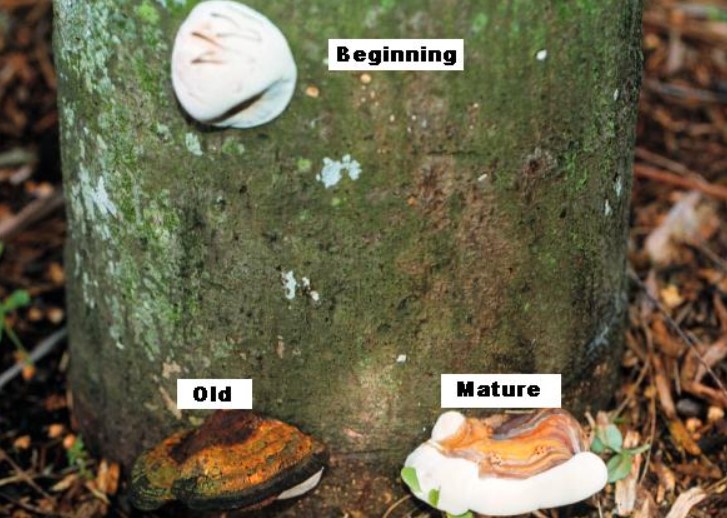Plants are always trying to grow and some of them don’t care where they grow out.
We have seen plants poking through cracks in the concrete in the search for light and warmth. There are also plants that will grow out of other plants and use some of their resources to thrive.
These plants also think that palm trees can make a great growing spot. If you see something growing out of your palm tree, most likely it is something that wants its resources.
Let’s see what is growing out of palm trees down below.
What’s Growing out of My Palm Tree?
When trying to identify what is growing out of your palm tree, remember that there are several plants that will think that the bark of a palm tree makes the perfect growing area.
Not every plant thrives in the soil or even in water. Instead, some think that resting on tree bark is comfortable and resource-rich.
Lichen
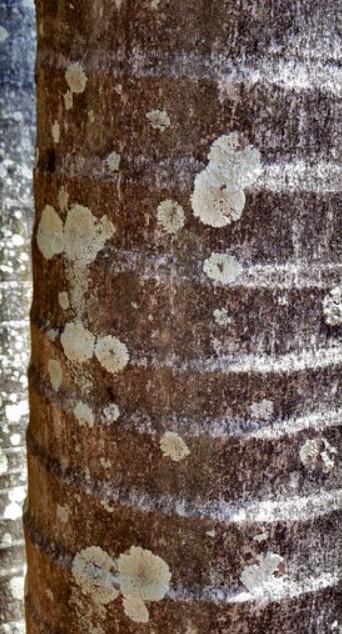
The most common plant that we will see growing out of trees, including palm trees. Lichen will grow in many different environments and can have a similar look to moss.
This plant is a symbiotic organism that uses a tree to get sunlight and other nutrients that it wouldn’t be able to on the ground. It’s mostly made up of algae and fungi and ends up looking greenish.
Don’t worry, it will not harm your palm tree if it is growing on it. In fact, it doesn’t really do much other than cover a part of the trunk of the tree.
Acai Berries
If you have an acai palm tree, it will eventually grow acai berries. These berries are orange in their color when they are unripe and become purple when they are ripe enough to eat.
These palm trees are incredibly tall and you will be able to see the berry’s colors when looking up near the leaves of the tree.
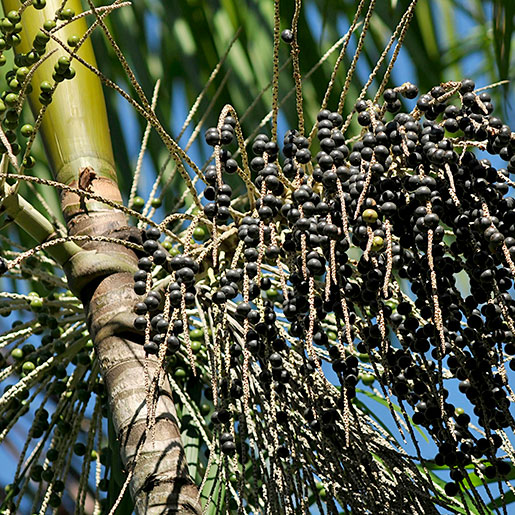
Of course, there is nothing to worry about when you see these berries growing. In fact, it is exciting because you are growing your own acai berries!
Who needs to pay a lot of money for an acai bowl when you can make your own with your own acai berries?
Seed Cones
When your palm tree is ready to reproduce, it will grow seed pods. These pods are found near the base of the leaves of your palm tree and look like pale pinecones or like a pale cattail.
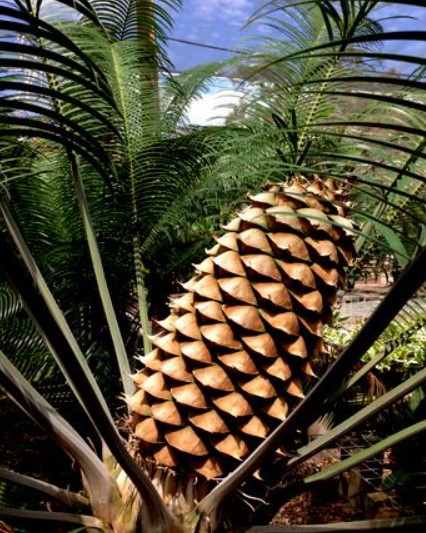
This is very normal for your palm tree to grow once it has reached maturity. You will likely see seed pods growing from your palm tree at regular intervals, like the same time every year.
Ganoderma Bud Rot
Now we get into what can grow on your palm tree and cause harm. As the name implies, Ganoderma bud rot is a fungal infection that will rot out the trunk of your palm tree.
This is not a fun situation for your palm tree to be in. Once your palm tree is infected, there is no cure. Your palm tree will end up dying because this fungal infection will completely rot out your tree to the point of it dying.
This rot starts out at the top of your palm tree, growing out from the center of the palm leaves, and works its way down and to the roots. If your tree is infected, you will see white-ish conks growing out of your palm tree.
You know that as soon as you see one of these conks, your tree is done for. As soon as you know that a tree is infected, you need to remove it from the ground, roots and all. This will help prevent the spread of this disease to other palm trees in the area.
Graphiola Leaf Spot
Graphiola leaf spot is another fungal infection that can cause a lot of damage to your palm tree.
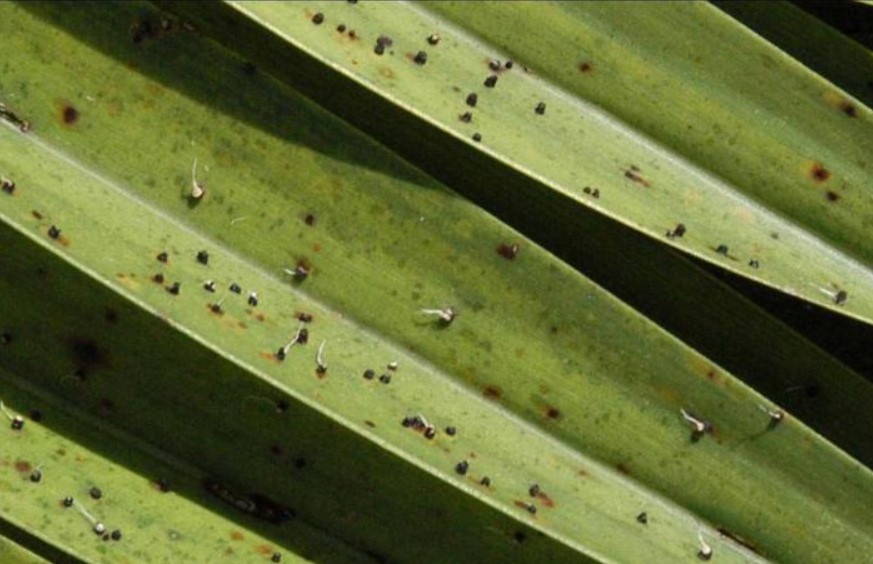
This disease only affects the Arecacae palm tree family, so if you have those in your yard, you should be aware that this disease can kill off those trees.
Instead of going down the trunk of the tree like bud rot, leaf spot will destroy the leaves first.
When your palm tree is infected, you will see black structures growing from the leaves. These structures will look similar to warts and will sometimes erupt white particles.
Unlike the bud rot, leaf spot does have a cure. Using fungicide is the best way to remove the spots from the leaves of your palm tree.
If left untreated, the leaf spot can spread, and it could end up killing your palm tree from being unable to go through photosynthesis.
However, it is best to work to prevent this disease than focus on curing future infections.
Make sure that you don’t plant your palm trees too close together. Allow there to be plenty of airflow and circulation between the trees.
Allowing for airflow prevents moisture from getting trapped in the leaves of your tree. Trapped moisture is the perfect spot for bacteria and fungus to grow, leading to this disease.
Orchids

Let’s head back to the nonharmful things that can grow on palms. Orchids have been known to grow up and along the trucks on palm trees. They don’t cause any harm to the tree as they don’t steal necessary nutrients or infect the plant.
Instead, orchids will add color to your palm tree, making it a prettier site. Some gardeners will purposely add orchids and other plants to palm trees for that pop of color. It makes your palm tree look cool!
There are several tutorials online that show you how to attach orchids to your palm trees if the orchids don’t already attach themselves. See this video for a guide.
You might like: How Do Palm Trees Survive in the Desert?
Frequently Asked Questions
Should Seed Pods Be Removed from Palm Trees?
Seed pods aren’t harmful to palm trees. They are actually very normal for palm trees to grow once they reached the proper maturity to start reproducing.
However, some might still wonder if these seed pods should be removed because of the idea that removing the seed pods will make the trees grow faster.
Though, there hasn’t been any evidence that removing the seed pods from your palm tree will make it grow faster. It might help with the reproduction of the tree go faster if you spread the seeds yourself, but there isn’t a lot of information on the topic.
It’s never a bad idea to let your palm tree go through the maturity process the way it wants to. Too much trimming, including removing the seed pods, could end up damaging your palm tree instead of helping it.
How Do I Get Rid of Palm Tree Sprouts?
If you don’t want any extra palm trees in your yard but you are seeing sprouts spread through your yard, you should remove them.
Use a dandelion removal tool to cut them out of the ground. You could also get the soil very wet and carefully pull them out of the ground. Be careful not to break off the top of the sprout and forget to remove the roots. Otherwise, the sprout will simply come back.
Should I Cut My Palm Tree Leaves?
Over time, palm tree leaves will get old and die off. In this situation, you should cut off the dead palm leaves so that new palm leaves can grow in their place.
If you feel that the palm leaves of your tree are getting out of hand, you can go ahead and cut off the extra ones of the tree. Just make sure that you don’t cut off too many because that can end up damaging the tree more. Only cut off what is necessary for the health and look of your palm tree.
How Often Do You Need to Trim a Palm Tree?
You actually don’t need to trim your palm tree that often. The leaves on the tree will stay healthy for a long time as long as they don’t get infected.
You really only need to trim your palm tree 1-2 times per year. Check on the look of your palm tree twice per year, at the beginning of their season and at the end. Look to see how healthy the leaves are and cut off the ones that are brown and drooping.
Check for diseases more often than that to make sure that any fungal disease isn’t hiding. Do health checks once every few months.
Final Thoughts
There are plants that will grow anywhere that they see fit. Sometimes, this means that a plant will grow on other plants such as the palm tree.
Do you have any lichen or other plants growing on your palm tree? Let us know in the comments!
Palm trees are relatively easy to take care of as they do much of the work themselves. Make sure that they stay healthy by seeing what is growing on your tree regularly.
